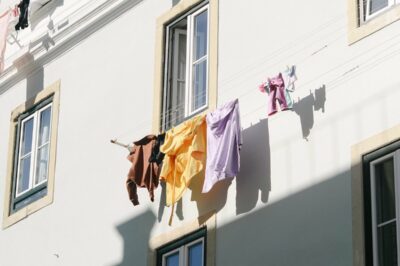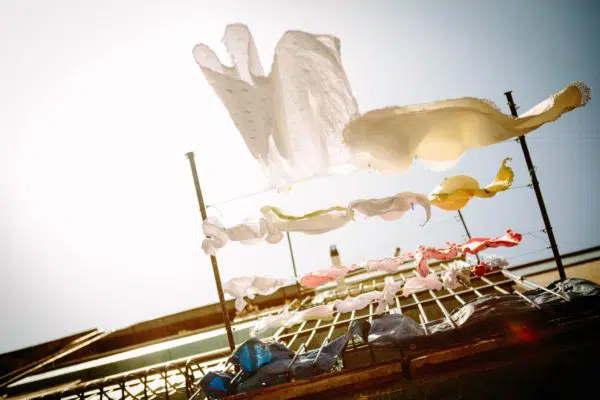Table of Contents[Hide][Show]
You can smell it when you walk down the laundry aisle. Sometimes it’s so bad you have to cover your nose.
All those perfumes!
It’s not just your imagination. In 2008, scientists reported on the toxic chemicals in laundry detergents and other laundry products. This probably comes as no surprise to you—most of us know that with synthetic fragrance come chemicals that our body doesn’t care for (to put it lightly).
Since 2008, more chemicals found in common grocery store detergents have surfaced. In fact, we found seven more, and have listed them for you here, along with some healthier alternatives. You shouldn’t have to suffer asthma or dermatitis just to have clean clothes.
Scientists Find Proof of What We’ve Suspected
First, let’s look at that study. Researchers from the University of Washington studied top-selling laundry and air-freshening products and found that they emitted dozens of different chemicals. All of them gave off at least one identified as toxic or hazardous under federal laws!
Worse—none of these chemicals was listed on the label.
Where were these chemicals found?
Among the products tested were a dryer sheet, a fabric softener, and a laundry detergent, as well as spray and plug-in air fresheners. Results showed nearly 100 volatile organic compounds (VOCs) emitted from the six products, and none were on the label. “Five of the six products emitted one or more carcinogenic ‘hazardous air pollutants,’ which are considered by the Environmental Protection Agency to have no safe exposure level,” said study author Anne Steinemann.
That’s not all. A later 2011 study by the same researchers found that air vented from machines using top-selling scented liquid laundry detergent and scented dryer sheets contained hazardous chemicals, including two classified as carcinogens.
What did scientists find?
For the study, researchers ran a load of laundry once with no products, once with a leading brand of scented liquid laundry detergent, and once with both the detergent and a dryer sheet. They captured the exhaust from the dryer vent with a canister.
An analysis of the captured air showed more than 25 VOCs, including seven hazardous air pollutants. The two carcinogens were acetaldehyde and benzene.
“These products can affect not only personal health,” said Steinemann, “but also public and environmental health. The chemicals can go into the air, down the drain and into water bodies.”
7 Toxic Chemicals in Laundry Detergent
Let’s look more closely at what manufacturers are putting into laundry detergents that may not be good for our health:
1. Fragrance:
This is one of the main problems, and the focus of the two studies above. Manufacturers combine a number of chemicals to produce a fragrance—so you’ll believe your clothes are clean because they smell clean—and they don’t have to list those chemicals on the label because of trade protection. As we’ve seen, some of those chemicals can be very toxic.
2. Cleaning agents (surfactants)
These are included in the formula to help the product clean better.
Examples include chemicals like quaternium-15 (known to release formaldehyde, a known carcinogen), diethanolamine (linked with skin and eye irritation and possibly liver problems), nonlphenol ethoxylate or NPE (toxic to nerves, irritating to skin, potential hormone disruptor, toxic to aquatic life), linear alkyl benzene sulfonates or LAS (irritating to skin and eyes and toxic to aquatic life; benzene on its own is a carcinogen), and petroleum distillates (linked to cancer and lung damage).
3. Stabilizers
These chemicals help stabilize the formula, so that it lasts longer on the shelf. Examples include polyalkylene oxide or ethylene oxide, which are linked with eye and lung irritation, and even dermatitis.
4. Bleach
Bleach may be used separately or may be included in the detergent itself. It’s known to irritate skin, eyes, and lungs, and when it mixes with wastewater, it can form toxic organic compounds that have been linked with respiratory issues, liver, and kidney damage.
5. 1,4-dioxane
This is a chemical by-product of detergent manufacturing. In independent tests, Women’s Voices for the Earth found 89 parts per million (ppm) in Tide Free & Gentle and 63 ppm in regular Tide. They helped increase awareness, and Proctor & Gamble agreed to reformulate to reduce levels to below 25 ppm. Future tests should show whether they made good on that promise.
6. Brighteners
You’ll find these in detergents advertising their “brightening” powers. Brighter whites! Brighter colors! What’s creating all this brightness? Chemicals that actually remain on the clothes to absorb UV light and help clothes “appear” brighter.
We’re talking things like naphthotriazolystilbenes (linked with developmental and reproductive effects), benzoxazolyl, diaminostilbene disulfonate, and more. Since these remain on the clothes, they are likely to come into contact with skin.
7. Phosphates & EDTA
Manufacturers use these to make detergents more effective in hard water, and to help prevent dirt from settling back on clothes when they’re washing. These chemicals have long been associated with environmental damage, particularly in our streams and waterways. They cause algae blooms that damage ecosystems.
Many detergents have eliminated these, but they’re often using ethylene diamine tetraacetic acid (EDTA) in its place, which does not readily biodegrade, and has been found to be toxic in animal studies.
Natural Alternatives
We don’t have to subject ourselves and our families to all these chemicals for the sake of clean clothes. Instead, there are a number of steps we can take to protect ourselves and the environment:
Make your own detergent
It’s not hard! All you need is a little washing soda, borax, and unscented bar soap like Dr. Bronner’s. Wellness Mama has a great recipe, and you can find others online as well.
Buy the safest you can
If you don’t want to do it yourself, look for the safer options out there. The Environmental Working Group has a great laundry guide where you can find those products that scored the lowest hazard rating.
Skip the fabric softener
A half-cup of vinegar added in the rinse cycle will produce the same results without the toxic chemicals.
Naturally remove stains
Instead of using chemical-laden stain removers, simply pre-treat your stain with a combination of washing soda, baking soda, and water.
Try real brightening
A little baking soda added to the wash cycle will naturally brighten colors, without the clingy chemicals to irritate your skin.
Dump the dryer sheets
Want to reduce static cling? Try a dryer ball. You can find them just about anywhere, or you can make your own. DIYnatural has directions, as does Petalstopicots.com. If you miss the fragrance of your dryer sheet, add your favorite essential oil to a damp rag and throw it in with your load during drying.
Frequently clean out your washer
This helps to get rid of any soap scum, bacteria, or other icky things that have collected in your machine over time. Simply add some white vinegar into a hot water cycle and run.
Do you make your own laundry detergent or dryer sheets? Please share your tips with our readers!
Sources:
University of Washington, “Toxic Chemicals Found in Common Scented Laundry Products, Air Fresheners,” Science Daily, July 24, 2008, http://www.sciencedaily.com/releases/2008/07/080723134438.htm.
Anne C. Steinemann, Lisa G. Gallagher, Amy L. Davis, Ian C. MacGregor, “Chemical emissions from residential dryer vents during use of fragranced laundry products,” Air Quality, Atmosphere & Health, 2011; http://link.springer.com/article/10.1007/s11869-011-0156-1.






sildenafil 100mg for sale https://eunicesildenafilcitrate.com/ sildenafil pharmacy prices
Its almost as if laundry detergent isnt food or a smelling salt.
There is always some sort of side effects of using detergents i feel.
Love using my plant based Thieves laundry soap! Ditching and switching! Thanks for sharing this great information.
I think it’s absolutely scandalous that these companies aren’t required by law to release their ingredients.
Great article, and really thought-provoking.
Regarding natural laundry detergents, I have heard reports of Indian Soap Nuts being a good alternative.
People are also using essential oils such as Lavender and Chamomile to make some, too.
Are Optical Brighteners found in 20 Mule Team Borax? The only contents I found on the box was sodium borate. Wanted to know if there were any additives in 20 Mule Team. Thanks!
M.
Hello very good information
I want to ask one small question
Can we mix potassium powder in
Washing powder for good results
The ingredient I find the most annoying is the ‘fabric softener.’ I keep wondering to myself why manufacturers can exchange harmful chemicals with safer ingredients. Thank you for the heads up on these toxic chemicals. With more public awareness, it is possible for these manufacturers to change their ways..
Ann Marie, good summary, thanks for sharing.
I like to smell detergents,is it dangerous?
I am very allergic to Gain products. Several of my neighbors are now using Gain and when they are drying their clothes I can not go out side without a toxic chemical mas on. if I do not it only takes about 5 seconds to start affecting me. I become very agitated, confused , My chest burns and this will last for a couple of hours. I have called Gain about this but they will not do anything about changing their products. Of course. They know what they are putting in their and products and they understand what it can do to us and the eviroment
I used to be fit and healthy leading a sporty life, with good nutrition. In 2010 I started to have unexplained chest pains. The heart specialists said I had a healthy heart and could not find anything wrong with me. In 2015 I had a stroke, the brain damage left my left side paralysed, and I became extremely sensitive to washing powders, perfumes and fabric softeners.
I am now walking and talking and can do basic maths again. I cannot go outside when my neighbours hang their washing out; we have to close all the windows. I cannot go to anyone’s house where they use scented washing powder or fabric softener. We cannot use the washing machine or dryer at home. I get dizzy after about 5 minutes of getting a smell of freshly washed clothes, more so when they have fabric conditioner in.
The problem was always the washing powder and fabric softener, which I did not know before the stroke. At the time of the stroke I had the washer and dryer both running.
Now that my allergy is much worse than ever, it is clear that it was the washing powder and fabric softener that caused the stroke. Two of my sons get eczema, and the other has breathing problems with washing powder perfumes and fabric softener.
I have been using laundry magnets for over 10 years now. No chemicals just 2 “hockey puck” sized magnets that last a lifetime.
I understand what you mean by closing your windows and not getting too close to anyone soaked in detergent/ dryer sheet odors. Some of my friends understand others are just rolling their yes back. Praying for enlightenment for those who don’t get it and that they may never have to endure the devastating side effects many of us experience.
I just read your comment about hockey pucks. Can you please tell me are you talking about hockey hockey pucks? Very interested. I get very sick from washing detergents and i swear everyone uses it on my street. thank you
This is why I use Young Livings Thieves Detergent…made with Grade A Essential Oils <3
I didn’t know Young Living had a laundry detergent?? I only knew of household cleaner liquid. Please advise. Thanks.
Yes…its fantastic! Smells good and is good for you! Made up of essential oils 🙂 One of my good friends just did a science fair project using thieves, bleach, and windex on a swab taken from the bathroom (around toilet, sink and tub)! All grew bacteria except for the one using thieves. I trust this product around my nieces and any pets!
Lois,
My apologies for my earlier comment, I saw cleaner and my mind went with cleaner lol The detergent is great, no remaining residues and a little goes a long way! Literally the amount they say to use is all you need. Smells fantastic too 🙂 They have a whole line of thieves products toothpaste, cough drops etc.
Thank you , I’m doing research for a course I run for domestic workers and Nannies in South Africa . Its a common job for the mass of unemployed women but these women are the highest exposed to these chemicals all day every day and then go home and use the very same stuff! My lives work is to educate and bring alternatives that are better for us and the planet . I found you info really helpful and will stay in touch .
With Much Gratitude
Jade Khoury
Low Impact Living
Isent borax toxic also please answer thank you
I havn’t tried this myself yet as I only very recently read about it, but soapnuts or soapberries (they are not actually nuts at all) are totally natural and can be used as a natural laundry detergent or you can make your own liquid soap from them. They grow on trees in warm climates and apparently there are different varieties with some better than others. The website provided has some very interesting bits of information about this product. It would seem like they would be economical too as you only use 5 or so for a load of washing and you can use them 4-5 times before composting. Sounds like a great idea so when my washing powder runs out I fully intend giving this a whirl.
The website is http://www.soapnuts.co.uk
I hear conflicting information about Borax and it’s safety and whether it’s safe to use. Is there a confirmed report somewhere that states it’s completely safe.
borax is a natural pesticide do not use it. you will contaminate your washing machine